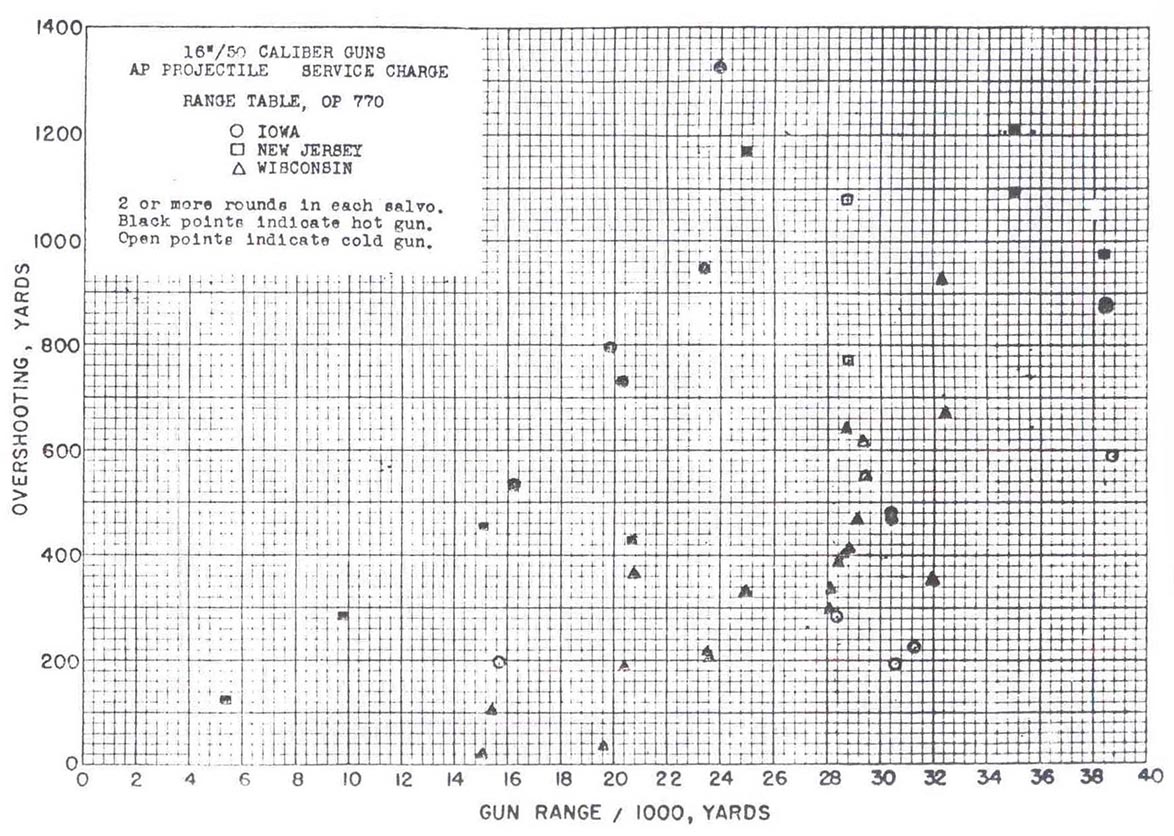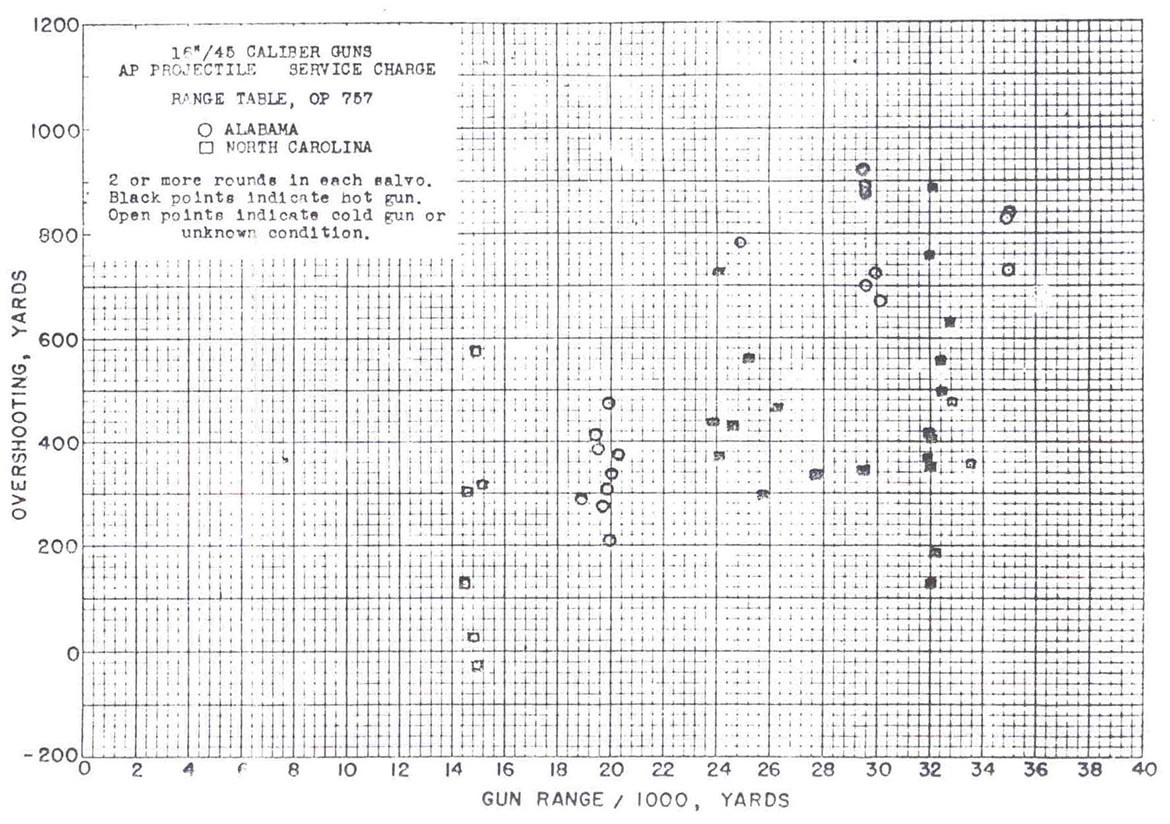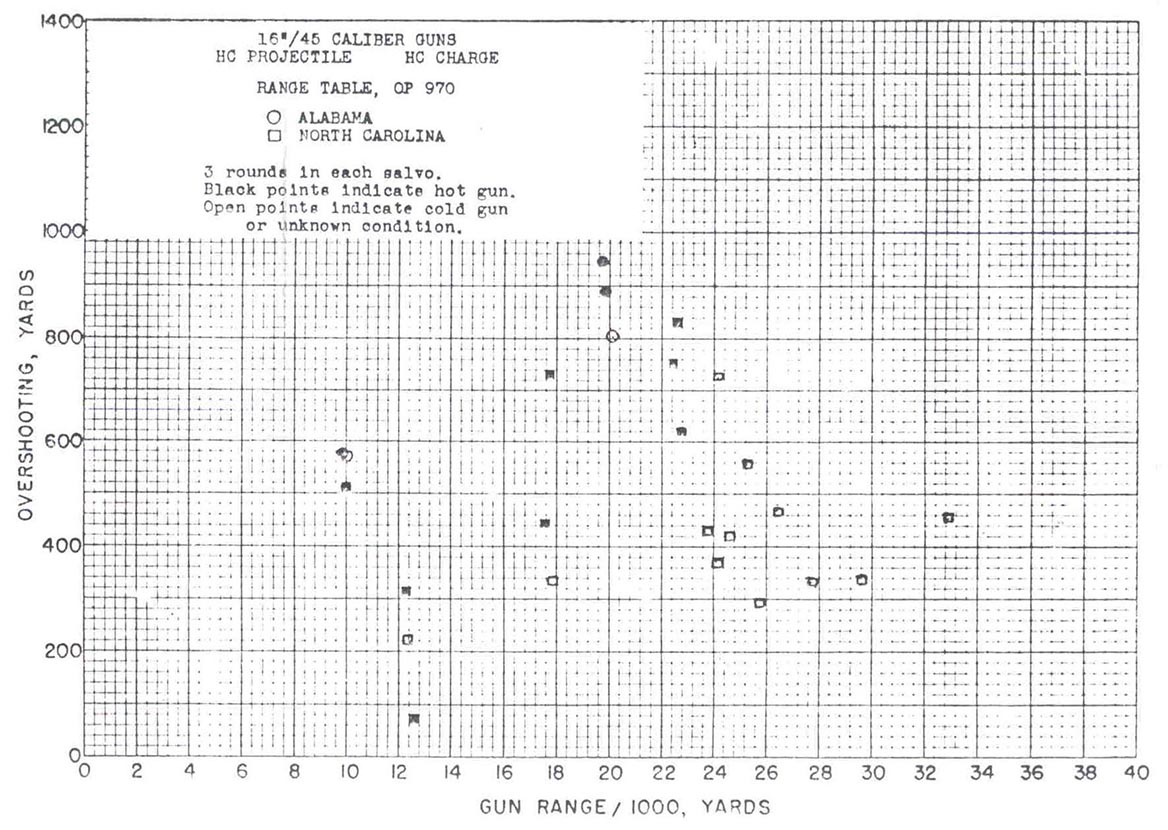
If you can see this text here you should update to a newer web browser
Normal | Highlight & Comment Highlighted Text will be in Yellow, but there are none yet
Bulletin of Ordnance Information No. 1-45 of 31 March 1945 (Excerpt)
|
MAIN BATTERY 68. Overshooting of 16" Guns. Reports from the fleet indicate that the problem of overshooting of 16' guns is still an active one. The first indications of overshooting were obtained about 1942 in the WASHINGTON, NORTH CAROLINA-class ships. The overshooting was most pronounced at the longer ranges; at the shorter ranges some undershooting occurred. Thorough investigations were undertaken with regard to powder charge assignments, range tables, erosion curves and powder temperature coefficients. 69. As a result of these investigations, a new system of powder charge assignment for all guns was instituted. Previously a powder was proved in one new gun only and the weight of charge based on the velocity to be obtained in that gun. Since then a new system of matching with a master standard powder has been inaugurated. The master powder and its charge for a given gun-projectile-velocity combination is established by conducting full powder proof procedures with it in at least three different new guns. The charge assigned to a new lot of powder for the same gun-projectile-velocity combination is based on a comparison firing between the new powder lot and the master powder. The matched or master powder method of powder proof, therefore, assumes that two given powder lots fired comparatively in the same gun on the same day will be affected similarly by similar unknown variables. The new gun method for powder proof assumes that all new guns perform perfectly and non-variantly. That the former assumption is more nearly true than the later is borne out by an analysis of results of proof firings conducted by both methods. The average error in muzzle velocity caused by errors of charge assignment of powder lots proved by the matched powder method is about 40% less than that for lots proved by the new gun method. 70. All 16" powdere have been re-proved by this method and the fleet informed of the corrections to be applied for the various indices of powder. As the data become available, new erosion curves, which also include the powder index corrections where applicable, are being issued. New powder temperature coefficients for all guns will be furnished in OP 1004 (Rev. 2), which will be issued shortly. The following table gives the data for 16" gune:
71. A complete series of firings, conducted at the Naval Proving Ground, Dahlgren, to check on the range tables, indicated that the undershooting at short range was due to the fact that the angles cf departure were appreciably less thin the angles of elevation, but at the longer ranges the firings were in agreement with the existing 16" range tables. The difference between angle of departure and angle of elevation is now being determined for all guns and will be incorporated in range tables. 72. Subsequent reports from the fleet indicated that the overshooting exists at longer ranges both in the 16"/45 and 16"/50 guns with both AP and HC projectiles at full and reduced velocities. It was considered possible that unseating might be a major cause and extensive tests were conducted at the Navel Proving Ground and afloat to determine the possibility of unseating under most severe service conditions. The results, however, were all negative in that no unseating oocurred. 73. The manner in which the overshooting increases with range suggests the possibility that the velocity obtained in guns aboard ship differs for some
|
|
reason from that obtained at the Naval Proving Ground. Two Independent methods to measure velocity aboard ship are under development. One consists of using HC projectiles with a special VT unit in the nose to determine the spin, and from the spin determine the velocity. This method is in the final stages of test at ths Naval Proving Ground and it is expected that tests will be conducted afloat shortly. Another method makes uss of special radars for measuring initial velocity. The first radar unit is expected at the Naval Proving Ground in the near future and, if the tests prove to be satisfactory, the same unit will be used for tests afloat. 74. All reports on calibration practices are being carefully examined and ths data analyted. The accompanying plots show the errors resulting under various oonditions for certain ships' firings. It is requested that future reports on calibration practices oontain oomplete detailed data on the method of computing the balllstics, range tables, erosion curves used, etc, in order to aid the Bureau in compiling and analyzing suoh data. 76. Main Battery Patterns. Based on Naval Proving Ground firings in single guns and a limited number of firings in triple mounts with delay coils, pattern sizes for the main batteries of battleshlpe should, under normal firing conditions, average approximately as follows for both AP projectiles, full charge, and HC projectiles, reduced charge:
76. Patterns of 6"/47 Guns. Recent reports have indicated that some ships having 6"/47 batteries are obtaining patterns which are too large. In order to obtain reliable data on the patterns of 6"/47 guns near the regunning period, the Bureau requested some time ago that the USS PHILADELPHIA be made available for a special firing before regunning in order to compare resulting patterns with those obtained at the Naval Proving Ground and those obtained in the service during earlier etages of wear. The accompanying table gives the results cf the PHILADELPHIA firing, a summary of Day Battle Practice firings for the period 1939-1941 (at which time the average ESR of the guns was only about 50) and a summary of Naval Proving Ground firings in guns of about 0, 600 and 1000 ESR. PATTERNS OF 6"/47 GUNS
" These data Include firing of partial, full- "" These data are all for single-gun firings.
|
|||||||||||||||||||||||||||||||||||||||||||||||||||||||||||
|
77. The patterns given in the table are the average of a large number of salvos. It is to be expected that for a relatively small number of salvos, the average pattern will differ from the figures given in the table. For 15-gun salvos, the mean error of the individual patterns is about 1/4 of the average pattern size. 78. The tabls indlcates that the patterns in the fleet do not, in general, differ materially from those at the Naval Proving Ground, and also that up to 600 ESR the patterns are not much larger than those of new guns. In general, the 6"/47 guns should have relatively small patterns up to their regunning point and, even when well-worn guns are fired beyond the regunnlng point, the patterns are still not extremely large. The explanation of abnormally large patterns in 6"/47 guns of medium wear must be searched for first in causes other than worn gun condition. In this connection, the Bureau has received some reports of the USS CLEVELAND battery with 1500 ESR firing at ranges of 12,000 to 20,000 yards during which an equivalent 15-gun pattern varying between 3% and 5% of the range was obtained. 79. Ballistic Modifications for Rangekeepers Mark 8. The Bureau has initiated a program to provide necessary ballistic computer cams for rangekeepers Mark 8 presently installed in CL's, CA's and BB's to accommodate both the AP' and HC projectiles with full and reduced charges. These rangekeepers will ultimately be supplied with two ballistic cams, one cam for AP projectiles when fired with full and reduced charges, and the second cam for HC projectiles when fired with full and reduced charges. The ballistic computer cams for the above rangekeepers are being designed for the projectiles and velocities as indicated in the table below. Manufacture is expected to be completed ae follows: CA's - September 1945, CB's and BB's 55-60 - October 1945, BB's 61-64 - November 1945, BB's 40-44, 45, 46 and 48 - December 1945, and CL's - January and February 1946. 80. Rangekeepers Mark 8 in CL'S 43, 46 and 47 are so designed that cams providing for four initial velocities cannot be installed. New rangekeepers are being procured for these ships which will accommodate the four initial velocities listed.
|
||||||||||||||||||||||||||||||||||||||||||||||||||||||||||||||||||||||||||||||||||||||||||||||||||||||||||||||||||||||||||||||||||||||||||||||||||||||||||||||||||||||||||||||||||||||||||||||||||||||||||||||||||||||||
|

|
|

|
|

|
|
vertical zones of the trajectory. When, however, no measured or estimated upper air winds can be obtained, the surface true wind must necessarily be used in entering these columns. Methods of making up ballistic wind are given in Bulletin of Ordnance Information, O.P. No. 561-I of May, 1923, and in Method of Computing Range Tables, O.P. No. 500 of April, 1929. 10. Column 19 shows how much the point of impact is raised or lowered on a vertical screen by raising or lowering the sight bar 100 yards, the actual range remaining fixed. 11. The change in range due to a variation of ±1 minute in the angle of elevation may be deduced from column 2b. 12. The effects of the rotation of the earth on range and deflection are given in two supplementary tables which follow the range table proper. 13. The powder is assumed to give normal velocity at 90°F. For each degree increase in temperature the initial velocity is increased approximately 2 f.s.; a decrease in temperature causes a corresponding decrease in velocity. 14. The firings upon which this range table is based are summarized below: Target Projectiles Mark IX Mods.
Note: the magazine temp. was 60-65°, and this resulted in a 30° difference than assumed 90° = possible error of 50-60 F/s in practice. |
|||||||||||||||||||||||||||||||||||||||||||||||||||||||||||||||||||||||||||||||||||||||
Bulletin of Ordnance Information No. 2-45 of 1945 (Excerpt)
|
MAIN BATTERY 91. PATTERN SIZES 5" TO 16" GUNS. Range patterns obtained from firings oonduoted at the Naval Proving Qround, Dahlgren, ara summarised in Tables I and II below. The figures repreeent the average unoorreoted or measured pattern obtained from s large number of firings. These firings were from single guns and consisted mostly of groups of from 3 to 6 rounds each at elevations from 10° to 30°. During the firing of each group, conditions were held as nearly oonstant as practicable. 92. Pattern sizes given in these tables provide a convenient yardstick for evaluating the dispersion performance of the batteries aboard ship. Table I gives the average site and mean error of 3-round patterns in percent of range. Pattern sites will vary considerably from salvo to salvo, but in a long series of firings about 60% of the patterns will lie within the limits established by the mean errors. For example, the 6"/47 gun haB a mean pattern of 1.1% of range and 60% of these individual patterns will vary in site from 0.6% to 1.6% of the range. TABLE I
TABLE II
93. Both Tables I and II are the averages for both AP and HC projectiles and also for both full and reduced charges. The difference in the average patterns for the various projectile charge combinations is not sufficiently large to warrant separate consideration. Table II was derived from Table I by using the appropriate multipliers from Table III (see next page), which is a conversion table based on statistical theory. 94. The multipliers in Table III are valid only on the assumption that all conditions are ae nearly uniform as practicable; i.e., all guns are aligned, magazine temperatures are approximately the same, corrections have been applied for any differences in ESR and in powder indices, projectilee are seated, delay coils are properly installed and the fire control system is properly adjusted. It is therefore to be expected that, in general, patterns in the fleet may be slightly larger than the figures given in the above tables.
|
|||||||||||||||||||||||||||||||||||||||||||||
|
RATIO OF AVERAGE SIZE OF PATTERN OF (N) GUNS TO SIZE OF PATTERN OF (M) GUNS
CONFIDENTIAL |
|
|
SOURCE:
Warship TechSpec via Dr. George H. Elder.
Transcribed by RESEARCHER @ LARGE. Formatting & Comments Copyright R@L.